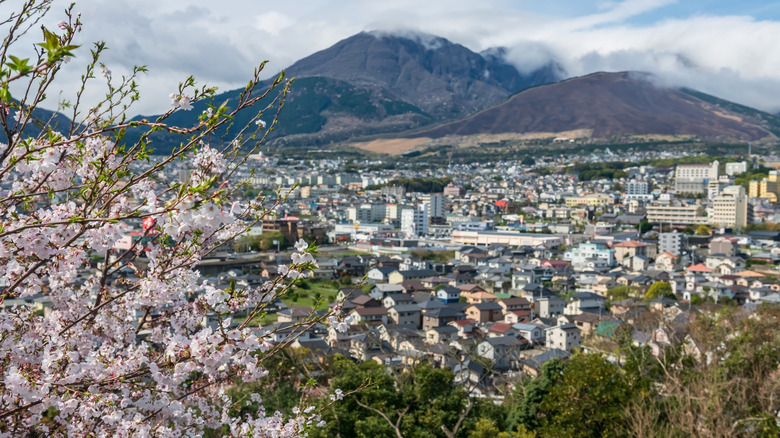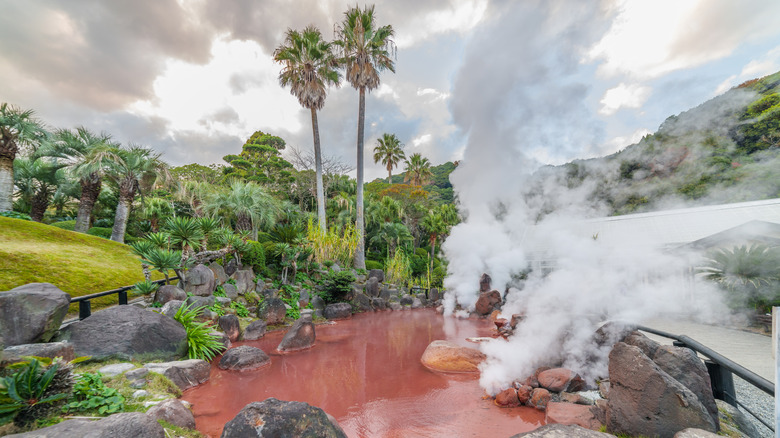One Of Japan's Largest And Most Famous Hot Spring Resorts Is A Beautiful Mountain City
Beyond sushi, cherry blossoms, and Mount Fuji, Japan is renowned for its hot springs. Known as onsen, these natural thermal baths have long been cherished in Japan for their therapeutic benefits. Onsen come in many forms from serene outdoor pools to the almost theme-park-like Yunessun Onsen –– which even features a wine bath. But few places embody the rich onsen tradition as perfectly as Beppu, a beautiful mountain city on the southern island of Kyushu.
Well away from the established Tokyo-Kyoto-Osaka route on the main island of Honshu, Beppu is a hidden gem city to add to your Japan bucket list. The city is not only western Japan's biggest hot spring resort, but it also produces more hot spring water than any of Japan's other onsen towns. When you arrive in Beppu, you'll see steam rising from the earth, swirling around the buildings that crawl up the hillside, and catch the tell-tale smell of sulfur that permeates the air. Backed by mountains and facing the tranquil Seto Inland Sea, Beppu is an incredibly scenic place to enjoy your first hot spring experience.
What to see and do in Beppu
Beppu has eight different hot spring areas, some in the city center and others in more rural, hillside areas. Each is home to public bathhouses and traditional inns (known as ryokans) with their own baths. If you want to fully immerse yourself in the hot spring culture, it's best to choose one of the ryokans so you can soak and stay all within the same hotel. There is a variety of services that are offered there too. Many have private onsen in the rooms, while others have atmospheric rooftop pools with impressive, scenic vistas. Everyone needs to experience the soothing warmth of a classic hot water soaking pool, as well as Beppu's sand, mud, and steam baths. Non-Japanese-speaking tourists can rest assured that staff here speak English and will explain what to do.
For a traditional experience, don't miss Takegawara Onsen, one of Beppu's oldest hot springs resorts. The baths reportedly have therapeutic benefits, like treating ailments like muscle stiffness and bruising. The sand bath, in particular, is an unforgettable treat. Another highlight is Beppu's famous Jigoku (or the Seven Hells of Beppu). The Seven Hells of Beppu are a collection of geothermal pools that are actually designed for viewing rather than bathing. Each site offers a unique spectacle, from vividly blue pools to bubbling crimson cauldrons. You can wander around the Jigoku on well-maintained paths and travel between them by bus. Many of them are in the Kannawa neighborhood, and it's here that you can try Beppu's most famous cooking method: jigoku-mushi, or hell-steaming. Pretty much any food can be steam-cooked over the fuming geothermal vents. Not only is this a unique experience, but the food is also delicious.
When and how to best enjoy Beppu
There's no bad time to visit Beppu, though the cooler fall and winter months make the hot springs all the more inviting. If you visit in spring, you might catch the glorious and fleeting cherry blossoms in bloom. Mount Tsurumi, which towers over Beppu and offers spectacular views of the city, is a particularly good place to see the delicate flowers.
Although Beppu lies almost 700 miles from Tokyo, it's easily accessible thanks to Japan's excellent transportation system. Oita Airport is around an hour away by bus or car. Flights from major Japanese cities like Tokyo and Osaka are frequent and tend to be reasonably priced as well. Beppu is also just a two-hour train ride from Kyushu's largest city, Fukuoka.
Finally, a note on bathing etiquette: Generally, you're not allowed to wear a bathing suit in Japanese hot springs; you need to be naked to enter the bath. While this can be a daunting prospect, remember that it's completely normal in Japan. If you need more privacy, there are plenty of private onsens available. You also need to be aware of the strict hair rule that dictates you wear a ponytail and keep your tresses out of the water. And finally, if you have visible tattoos, you may be turned away at an onsen, so always check on the rules beforehand.


